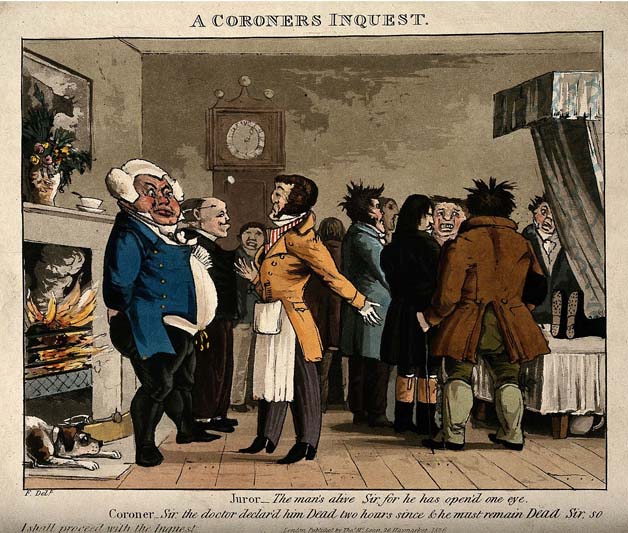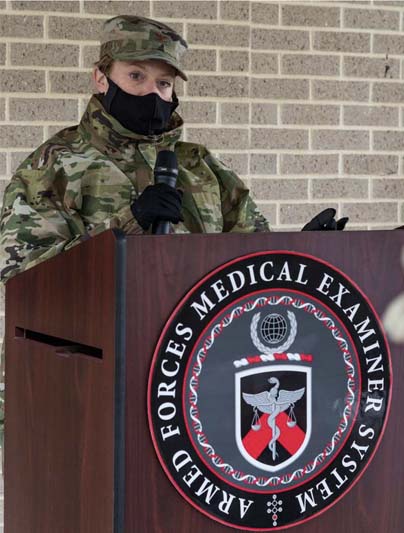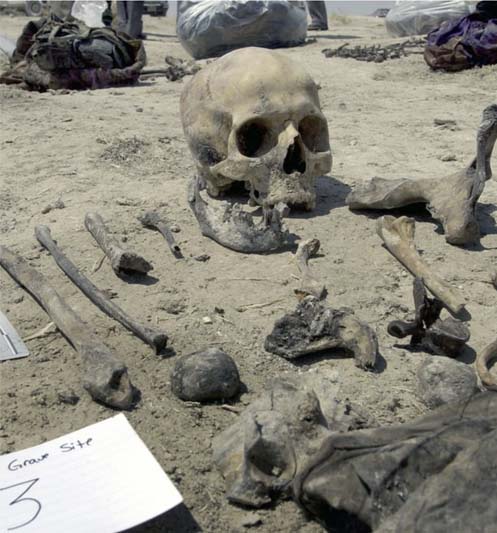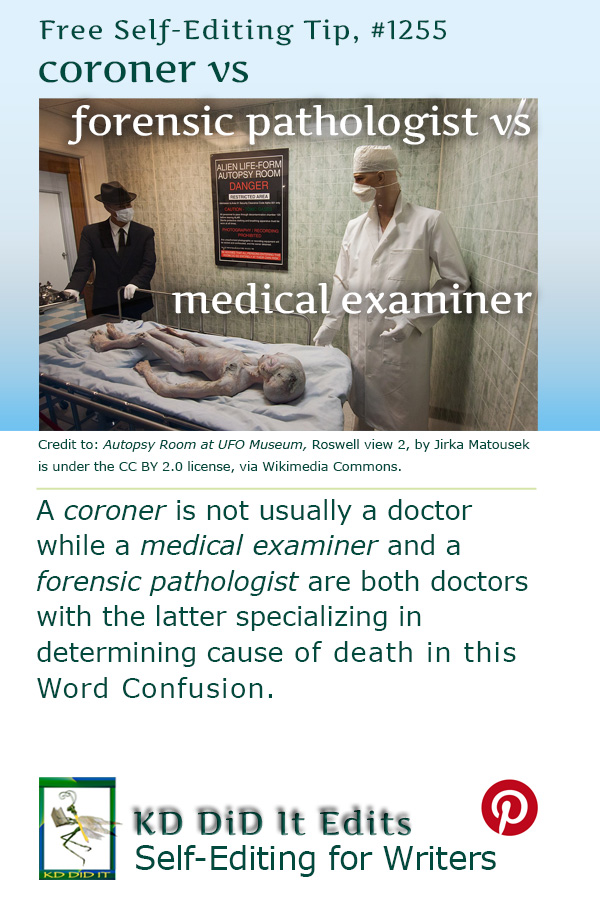I do love reading mysteries, suspense, and thrillers, so naturally those job titles — coroner, medical examiner, and forensic pathologist — pop up frequently.
One of the more interesting facts I discovered is that the terms medical examiner and forensic pathologist are frequently swapped, leading to that confusion between the two, i.e., it can depend on whether a county uses a coroner system or not. If yes, then a forensic pathologist is frequently given the title of medical examiner.
A coroner doesn’t even have to have any medical training! So don’t die where the county uses a coroner!
On the whole, these two, medical examiner and forensic pathologist do appear to perform the same duties and require the same basic qualifications. In addition, a forensic pathologist has additional training in investigating the cause(s) of death and can perform extensive testing of tissue, blood, and other bodily fluids.
Exploring Later . . .
Some somewhat related posts include “Breadth vs Breath vs Breathe“, “Heart Beat versus Heartbeat“, and “Patience versus Patients“.
Word Confusions . . .
. . . started as my way of dealing with a professional frustration with properly spelled words that were out of context in manuscripts I was editing as well as books I was reviewing. It evolved into a sharing of information with y’all. I’m hoping you’ll share with us words that have been a bête noire for you from either end.
If you found this post on “Coroner vs Forensic Pathologist vs Medical Examiner” interesting, consider subscribing to KD Did It, if you’d like to track this post for future updates.
| Coroner | Forensic Pathologist | Medical Examiner | |
|---|---|---|---|

A Juror Protesting That the Subject of a Coroner’s Inquest is Alive, 1826, is courtesy of Wellcome Images and under the CC BY 4.0 license, via Wikimedia Commons. |

Colonel Alice Briones, Armed Forces Medical Examiner System by Roland Balik, US Air Force, is courtesy of Defense Visual Information Distribution Service and is in the public domain, via NARA & DVDS Public Domain Archive. |

Forensic Pathologists Investigate Mass Grave, 2003, Mosul, Iraq, by MSGT Robert R. Hargreaves, USAF, and is courtesy of the US National Archives and is in the public domain, via NARA & DVDS Public Domain Archive. |
|
| Part of Grammar: | |||
| Noun
Plural: coroners |
Noun
Plural: forensic pathologists |
Noun
Plural: medical examiners |
|
An official, typically elected or appointed to their position, who investigates violent, sudden, or suspicious deaths and determines whether an autopsy is required
|
Part of a broader field called forensic science and a subspecialty within the medical specialty of pathology
A physician with specialized training in general pathology and a forensic pathology fellowship
|
A physician trained in traditional medicine and the forensic sciences
A physician who oversees the death investigation system Usually is not required to be a specialist in death investigation or pathology and may practice any branch of medicine |
|
| Examples: | |||
| “Many coroners are not physicians and so they usually will retain a forensic pathologist to perform the autopsies” (Gill).
In many states, a coroner can be anyone at least 18 years of age, not a felon, and registered to vote in the county. Dr Sara Linton is the coroner in Karin Slaughter’s Grant County thriller series. |
Forensic pathologists may also provide consultation services to attorneys, families, and others.
Dr Kay Scarpetta, in Patricia Cornwell’s Kay Scarpetta series, is a forensic pathologist. Dr Michael M. Baden, “an American physician and board-certified forensic pathologist, is known for his work investigating high-profile deaths and as the host of HBO’s Autopsy” (Baden). |
Dr Li Morris, the chief medical examiner in the NYPSD, is a character in JD Robb’s In Death police procedurals.
Dr Wren Muller, a forensic pathologist, is the medical examiner in Alaina Urquhart’s The Butcher and the Wren. Dr Baden was also “the chief medical examiner of the City of New York from 1978 to 1979” (Baden). |
|
| History of the Word: | |||
| In 925, the English coroner’s office came into existence with a formal description is found in the Articles of Eyre in 1194.
In 1877, a law was enacted in England requiring an inquest to be conducted whenever the coroner had reasonable cause to suspect violent or unnatural death or when the cause of death was unknown, becoming a broad spectrum investigative agency concerned with all deaths. Middle English from the Anglo-Norman French coruner, from corune meaning Source: Choo |
Forensic comes from the Latin forum which means public and pathology comes from the Greek word for suffering.
As early as fourth century BC in Babylonia autopsies were performed but limited to animals. Giovanni Bathista Morgagni (1682- 1771) is considered to be the founder of the autopsy. In 1819, pathology was recognized as a distinct scientific discipline at the University of Strassburg. In 1920, Edmond Locard (who developed a forensic science theory that “every contact leaves a trace”, known as Locard’s exchange principle) created a crime laboratory, the first that brought together all these specialties for the purpose of criminal investigation. In 1918, Dr. Charles Norris was appointed the first chief medical examiner for New York City. In 1923, the first complete crime laboratory was built in Los Angeles, and in 1932, the FBI organized a laboratory that made forensic sciences available on a nationwide basis for the first time in the United States. In 1936, the American Board of Pathology began certifying pathologists. In 1959, forensic pathology became a subspecialty. Source: Choo |
In 1877, the first medical examiner system was introduced in Massachusetts.
In 1915, New York City eliminated the coroner’s office and created a medical examiner system with a designated pathologist as Chief Medical Examiner, creating today’s system. Source: Choo |
|
C’mon, get it out of your system, bitch, whine, moan . . . which words are your pet peeves? Also, please note that I try to be as accurate as I can, but mistakes happen or I miss something. Email me if you find errors, so I can fix them . . . and we’ll all benefit!
Satisfy your curiosity about other Word Confusions on its homepage or more generally explore the index of self-editing posts. You may also want to explore Book Layout & Formatting Ideas, Formatting Tips, Grammar Explanations, Linguistics, Publishing Tips, the Properly Punctuated, Writing Ideas and Resources, and Working Your Website.
Resources for Coroner vs Forensic Pathologist vs Medical Examiner
Some of these links may be affiliate links, and I will earn a small percentage, if you should buy it. It does not affect the price you pay.
Apple Dictionary.com
“Michael Baden.” Wikipedia. 3 Feb 2024. Accessed 3 Feb 2024. <https://en.wikipedia.org/wiki/Michael_Baden#>.
Choo, Tae M. and Young-Shik Choi. “Historical Development of Forensic Pathology in the United States.” Department of Political Science and Criminal Justice School of Social Sciences. Gainesville State College.and Division of Forensic Medicine. National Forensic Service. 10 May 2012. Accessed 3 Feb 2024. <https://synapse.koreamed.org/upload/synapsedata/pdfdata/0018kjlm/kjlm-36-15.pdf>. <http://dx.doi.org/10.7580/KoreanJLegMed.2012.36.1.15>.
“Forensic Medical Examiner vs Forensic Pathologist: What’s the Difference?” Foresight. 31 Mar 2022. Accessed 2 Feb 2024. <https://www.foresight.expert/news/forensic-medical-examiner-vs-forensic-pathologist-what-s-the-difference>.
Gill, James “What You Need to Know About Forensic Pathology.” College of American Pathologists. n.d. Accessed 29 Jan 2024. <https://www.cap.org/member-resources/articles/what-you-need-to-know-about-forensic-pathology>.
“So You Want to Be a Medical Detective . . .” National Association of Medical Examiners. n.d. Accessed 2 Feb 2024. <https://name.memberclicks.net/assets/docs/What%20is%20a%20forensic%20pathologist%2011-16-20.pdf>.
Pinterest Photo Credits
Autopsy Room at UFO Museum, Roswell view 2, by Jirka Matousek is under the CC BY 2.0 license, via Wikimedia Commons.


